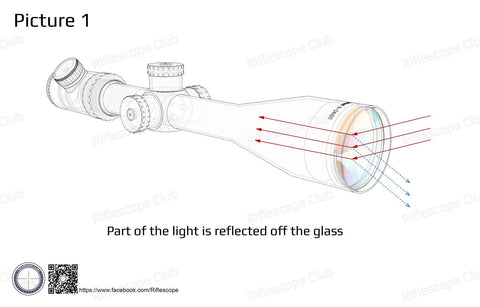Your Cart is Empty
Customers Outside The United States, Please Go To Our Europe Store or Global Store To Order.
Customers Outside The United States, Please Go To Our Europe Store or Global Store To Order.
Evelyn: Stephen, are you free now, can we talk about lens coating?
Stephen: Sure, any confusion?
Evelyn: I can fully realize that coating can provide us a brighter image, but I don’t know why and how.
Stephen: Okay, Evelyn, coating is not difficult to understand. In Wikipedia, an optical coating is one or more thin layers of material deposited on an optical component such as a lens or mirror, which alters the way in which the optic reflects and transmits light.
Evelyn: How does coating alter the way light reflects and transmits?
Stephen: It is well known that ocular lens, objective lens and the internal lens of the scope are all made of silicon dioxide, that is, glass.
When the light enters the scope, some of the light passes through the glass while the other part is reflected back by the glass. (Picture 1)

Evelyn: I see. Does more light pass through the glass mean the higher light transmission?
Stephen: Yeah, to reduce reflective loss and improve light transmission, coating comes in handy. Do you know how much coating contributes to reducing the loss of light?
Evelyn: I have no idea.
Stephen: Without a coating, each side of the glass loses about 4%-6% of its light transmission, which could be a 30%-40% loss of light transmission for a high-end side focus scope with total 13-14 pieces of lens.
Evelyn: This is a great loss!
Stephen: Yes, absolutely! Depending on the layers, Coating is different.

Evelyn: Do multi-coated lenses perform better than single-coated lenses?
Stephen: The answer is yes. Generally, more layers mean less light reflection. Facing different wavelengths of light, more coatings can act on more different wavelengths of light. Single layer coating can reduce the loss of light transmission to 2%, while multi-layer coating can reduce it up to 0.1%!
Evelyn: It’s incredible!
Stephen: That’s why some high quality refilescope’s light transmission can reach to more than 95%! Coating increases light transmission by reducing light reflection, allowing us to see a brighter image. Under strong light, coating reduces glare and makes the image clearer. From the picture 2 we can clearly see the difference with and without coating.

Evelyn: The difference is indeed very obvious!
Stephen: What’s more, the number of the coating layer related to the time consuming of coating. The more layers, the more time it takes and the higher the cost and technical requirements. However, coating only contributes to the light transmission. Resolution, contrast, and other factors that affect image quality are determined by the optical system, lens materials, glass quality, and machining precision.
Evelyn: It makes sense.
Stephen: In addition to improving imaging, coating protects the lens too. During the use of the scope, the lenses are inevitably exposed to weather or accidents which will cause wear and tear. Coating can protect the lens, slowing down the wear and tear, and allowing the lens to last longer.
Evelyn: What a surprise!
Stephen: With the development of technology, there are more and more types of coatings including Abrasion-Resistant Coatingswhich are specifically designed to protect lenses.
Evelyn: Any other kinds of coating?

There are also Water Repellent Coatings for water and fog resistance.(Picture 4)
Stephen: The most common is the coating I mentioned above to reduce the reflection of light as the main function of the coating is called Anti-Reflective Coatings.
Evelyn:Got it. Can you tell me something about how the coating is applied to the lens?
Stephen: Sure. There is a great deal to discuss about coating.
Evelyn:Thanks!
Comments will be approved before showing up.
LPVO vs MPVO: Which scope will take your shooting to the next level? LPVOs offer unmatched versatility for close-range targets, while MPVOs deliver precise long-range accuracy. Discover which one suits your hunting or shooting style and gives you the edge!
Choosing between HD, ED, and HT lenses for your rifle scope can be tricky. HD lenses provide clearer, more accurate images, while ED lenses reduce color distortion for sharper detail. HT lenses maximize light transmission for better visibility in low light. Which one fits your needs best?


